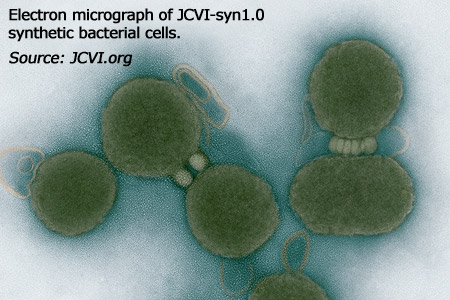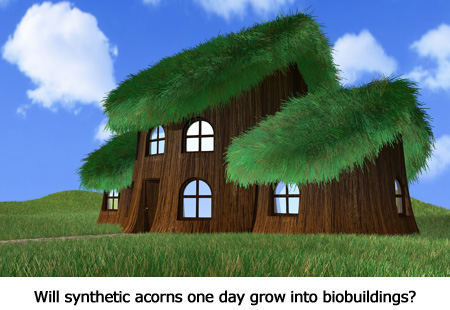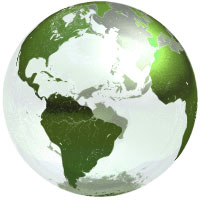 |
|
|
|
You are in: Future Technologies : Synthetic Biology
Synthetic Biology
NOTE: This page will receive a major update very soon! Life is rather good at using stored information and basic materials to grow very complex things. If human beings could similarly learn to build and control novel living systems it could therefore trigger an biotech revolution to rival that of the Internet or microelectronics. For many years, genetic engineering has been used to modify existing organisms by splicing a gene or few from one species into the DNA of another. However, we are now on the edge of going far further and creating new and completely artificial forms of life. Synthetic biology involves the design and construction of entirely new biological systems from standardized genetic components, together with the radical redesign of existing life for new purposes. Or, as the Biotechnology Industry Association explain, "synthetic biology is a new interdisciplinary area that involves the application of engineering principles to biology. It aims at the (re-) design and fabrication of biological components and systems that do not already exist in the natural world". The following provides a brief overview of synthetic biology and its current and potential future applications. You can also learn more by watching my five-minute Synthetic Biology video. The First Synthetic Living ThingSynthetic biology really hit the headlines in May 2010 when the J. Craig Venture Institute created the first entirely synthetic life form. Termed "JCVI-syn1.0", this self-replicating, single-cell organism was based on an existing Mycoplasma capricolum bacterium. However, at its core was an entirely synthetic genome constructed from 1.08 million DNA base pairs in the JCVI laboratory. JCVI even developed their own alphabetic code based on the four DNA base pair letters G, T, C and A. They then used this code to write watermarks into the DNA of their synthetic bacteria. Anybody who can crack the code is invited to use it to e-mail the JCVI scientists! 
The creation of JCVI-syn1.0 was the culmination of a ten year research process that cost an estimated $40 million. It was also controversial in many quarters. Not least, President Obama immediately asked his bioethics commission to investigate the matter. This body reported back that there is no need to halt synthetic biology research, nor to impose any additional regulations on the new field. For the time at least, synthetic biologists are therefore being left alone to self-regulate as they hone their God-like powers. Building with BioBricksOne of the most amazing things about synthetic biology is how advanced the tools and components of its trade have already become. For example, the PartsRegistry.org website now contains a free, "continuously growing collection of genetic parts that can be mixed and matched to build synthetic biology devices and systems". Such parts can now also be purchased from companies including New England BioLabs. Already they even sell a $235 BioBrick Assembly Kit. Meanwhile, OpenWetWare.org have made available this great Conceptual Instruction Manual for Synthetic Biology. A great deal of practical, technical information on creating synthetic biological systems using standardised components is also freely available from The BioBricks Foundation. Set up by engineers and scientists from MIT, Harvard and other research teams, this not-for-profit organization encourages the development and responsible use of technologies based on standardized or "BioBrick" DNA parts. Some useful resources are also available from the Synthetic Biology and Systems Biology Gateway.
Synthetic Biology ApplicationsSynthetic biology potentially has a wide range of applications. Many of these may be biomedical. For example, an initiative called the Artemisinin Project is planning to use synthetic biology to help treat malaria. Their aim is to manufacture a low-cost, semi-synthetic version of the malaria medication artemisinin. To this end, the team is assembling a pathway of genes taken from the Artemisia annua plant and other sources. This artificial gene sequence will then be spliced into the DNA of micro-organisms. The hope is to produce high qualities of artemisinin at low cost using industrial fermentation processes already common in the biotechnology industry. If this goal is reached then millions of lives may be saved. Other medical applications of synthetic biology may include new biocosmetics that contain synthetically-produced stem cells to help regenerate the skin. Research is also already underway that hopes to use synthetic biology in the manufacture of improved biochemicals. At present one of the most promising alternatives to oil-based plastics is polylactic acid (PLA). This is currently made from corn or sugar cane using a two-stage process. Firstly the agricultural ingredients are fermented with bacterium to produce lactic acid. A second chemical, post-processing stage is then needed to link the short lactic acid molecules together into long polymer chains. However, as reported here, a team from the Korea Advanced Institute of Science and Technology have already succeeded in producing PLA directly in a single process using a re-designed E.coli bacterium with a set of synthetic genetic pathways. Once commercialized, this will allow large quantities of PLA to be produced as a cost-effective substitute to petroleum-based plastics. In a similar vein, OPX Biotechnologies is using synthetic biology to develop a bioacrylic. A third broad area of synthetic biology application is in the development of next-generation biofuels. In fact, following the creation of JCVI-syn1.0 by JCVI, several patents to this effect were filed by one of its commercial sister companies, Synthetic Genomics. Also pushing forward the frontiers of synthetic biology, a Californian biotechnology company called LS9 is now developing synthetic E.coli bacteria that can convert natural carbohydrates to one of two biodiesel alternatives. There are also several projects worldwide looking to apply synthetic biology in the creation of third-generation bioethanol. First generation bioethanols are already being produced from cereal crops grown on land that is really required to feed human beings or that used to contain forests. Second-generation bioethanols are therefore thankfully starting to be produced from weeds and woods. However, far more significant will be the use of synthetic biology to help create third-generation or "advanced bioethanol" from algae rather than traditional land-grown crops. For example, a Mexican company called BioFields is planning to start commercial production of an algae-based biofuel in 2014. A final wide area of synthetic biology application may also be in bioelectronics. Not least, future electronic sensors capable of detecting tastes and smells may be built or grown using synthetic biotechnology. We may also see the development of biochips and biomicroprocessors as envisaged in my Biocomputer Unboxing video. You can learn a lot more about the existing and near-future applications of synthetic biology in this great guide to the Current Uses of Synthetic Biology. Future Games With LifeAsk somebody skilled in genetic modification to build you a better wooden house and they may well splice a few extra genes into an acorn to make it grow into a better oak tree. This tree would then be felled to produce the timber required to make your building. However, set a future synthetic biologist the same challenge, and they would be more likely to make radical changes to an acorn's genome so that it grew directly into a biobuilding. 
As crazy as the above may sound, synthetic biology really is about taking control of the natural world at the DNA level in order to accomplish previously impossible things. Programming an acorn to grow directly into a wooden building may sound ludicrous. However, given that an acorn can grow one kind of wooden structure using no more than dirt and sunlight, altering its code so that it produces another from the same raw materials is not a totally out-of-this-world scenario. As has already been noted, in the future synthetically altered bacteria will be used to turn organic materials into the bioplastic PLA. But why stop there? Why not use synthetic biology to create a tree that grows a crop of plastic bottles? And why indeed stop there? If a tree can grow plastic bottles and fruit, then why not mash its DNA a bit further to have a tree that yields up bioplastic bottles pre-filled with a soft drink? In the future it may not only be bananas that come in their own organic packaging. However outlandish it may sound at present -- and let's face it writing an e-mail address into an E.Coli bacterium sounded pretty crazy not that long ago -- synthetic biology is likely to present us with a great many opportunities and dilemmas. As discussed in my Challenging Reality TV Show Playing at God?, increasingly we will be able to program and reprogram the codes of life itself. Many people will at least initially greet such developments with open arms. However, for others, some or all such developments are likely to be considered unnatural and potentially unethical. As reported by Time Magazine, "the path of progress [in synthetic biology] cuts through the four-way intersection of the moral, medical, religious and political -- and whichever way you turn, you are likely to run over someone's deeply held beliefs". This said, now that JCVI has let the genie out of the bottle, it is very unlikely to be put back in. Future vertical farms may therefore be home to a great many synthetic micro-organisms, plants and even animals that have been designed a gene at a time. More information on synthetic biology can be found in my books 25 Things You Need to Know About the Future, and more recently The Next Big Thing.. Return to Future Technologies. |
 Synthetic biology creates new life using standarized biological components.  Read more in "The Next Big Thing". |
|
|